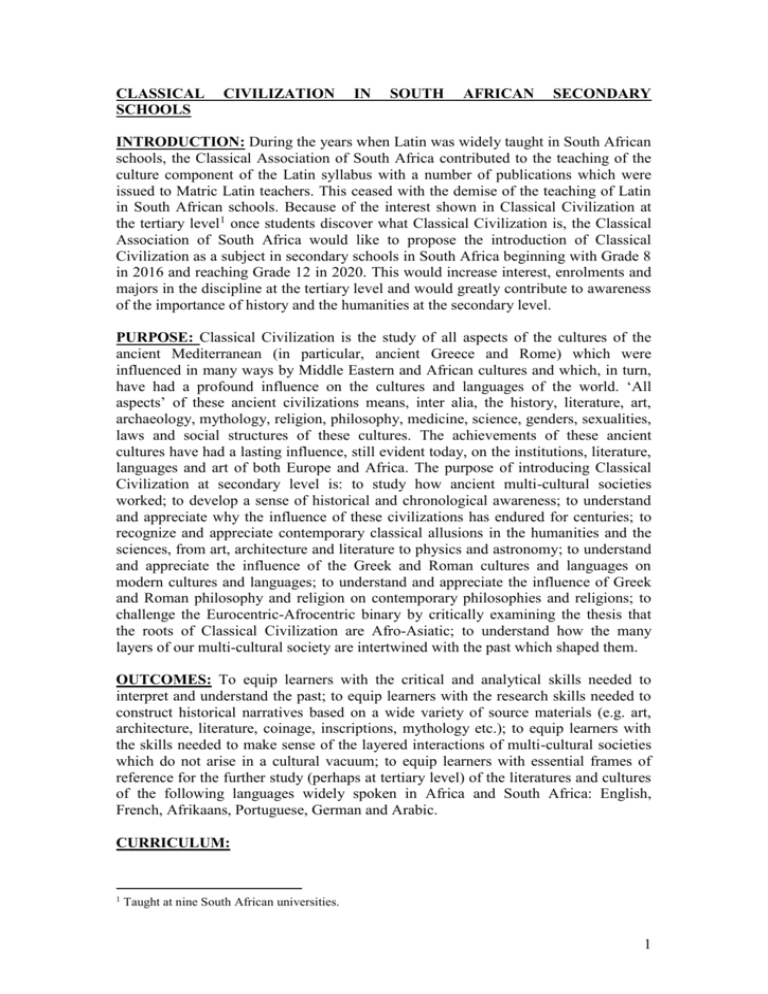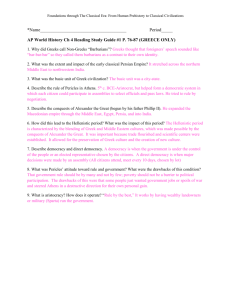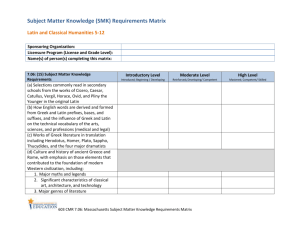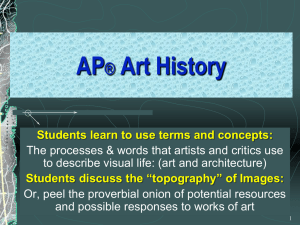CLASSICAL CIVILIZATION IN SOUTH AFRICAN SECONDARY
advertisement

CLASSICAL SCHOOLS CIVILIZATION IN SOUTH AFRICAN SECONDARY INTRODUCTION: During the years when Latin was widely taught in South African schools, the Classical Association of South Africa contributed to the teaching of the culture component of the Latin syllabus with a number of publications which were issued to Matric Latin teachers. This ceased with the demise of the teaching of Latin in South African schools. Because of the interest shown in Classical Civilization at the tertiary level1 once students discover what Classical Civilization is, the Classical Association of South Africa would like to propose the introduction of Classical Civilization as a subject in secondary schools in South Africa beginning with Grade 8 in 2016 and reaching Grade 12 in 2020. This would increase interest, enrolments and majors in the discipline at the tertiary level and would greatly contribute to awareness of the importance of history and the humanities at the secondary level. PURPOSE: Classical Civilization is the study of all aspects of the cultures of the ancient Mediterranean (in particular, ancient Greece and Rome) which were influenced in many ways by Middle Eastern and African cultures and which, in turn, have had a profound influence on the cultures and languages of the world. ‘All aspects’ of these ancient civilizations means, inter alia, the history, literature, art, archaeology, mythology, religion, philosophy, medicine, science, genders, sexualities, laws and social structures of these cultures. The achievements of these ancient cultures have had a lasting influence, still evident today, on the institutions, literature, languages and art of both Europe and Africa. The purpose of introducing Classical Civilization at secondary level is: to study how ancient multi-cultural societies worked; to develop a sense of historical and chronological awareness; to understand and appreciate why the influence of these civilizations has endured for centuries; to recognize and appreciate contemporary classical allusions in the humanities and the sciences, from art, architecture and literature to physics and astronomy; to understand and appreciate the influence of the Greek and Roman cultures and languages on modern cultures and languages; to understand and appreciate the influence of Greek and Roman philosophy and religion on contemporary philosophies and religions; to challenge the Eurocentric-Afrocentric binary by critically examining the thesis that the roots of Classical Civilization are Afro-Asiatic; to understand how the many layers of our multi-cultural society are intertwined with the past which shaped them. OUTCOMES: To equip learners with the critical and analytical skills needed to interpret and understand the past; to equip learners with the research skills needed to construct historical narratives based on a wide variety of source materials (e.g. art, architecture, literature, coinage, inscriptions, mythology etc.); to equip learners with the skills needed to make sense of the layered interactions of multi-cultural societies which do not arise in a cultural vacuum; to equip learners with essential frames of reference for the further study (perhaps at tertiary level) of the literatures and cultures of the following languages widely spoken in Africa and South Africa: English, French, Afrikaans, Portuguese, German and Arabic. CURRICULUM: 1 Taught at nine South African universities. 1 GRADE 8: An introduction to the gods, goddesses, heroes, heroines and monsters of Greek mythology, using as many of the primary sources as possible (e.g. Homer, Hesiod and Greek tragedy), and encouraging interpretation of the myths where appropriate. The Trojan War: the Houses of Atreus and Tyndareus, the marriage of Peleus and Thetis, the Judgment of Paris, The War (focus on Achilles, Hektor, Helen, Andromache), the Trojan Horse, the Return of Agamemnon, the Return of Odysseus). Background Texts: an accessible translation, version or adaptation of Homer’s ‘Odyssey’; a contemporary engagement with Greek mythology (e.g. The Percy Jackson series and the films adapted from the series). Project: comparative GreekAfrican or Greek-Hindu mythology. Recommended websites on Classical Mythology: recommended sites for classical art (e.g. the Beazley Archive at Oxford, which arranges vase paintings in categories such as gods, goddesses, heroes etc.). GRADE 9: Bronze Age Crete and mainland Greece: an introduction to the history, art and archaeology of the Minoan civilization, with focus on the Palace of Knossos and the work of Arthur Evans; a study of Akrotiri and the volcanic eruption on Thera; an introduction to the history, art, archaeology and language of the Mycenaean civilization, with focus on Mycenae and the work of the Schliemanns both at Troy and Mycenae; mythology related to Minoan Crete (Europa and the Bull, Minos and Pasiphae, Daedalus and Icarus, Theseus, the Minotaur and Ariadne) and Mycenae (the Perseus cycle). Background texts: relevant extracts from Herodotus for the history and from Ovid’s ‘Metamorphoses’ for the mythology. Project: the bull in Minoan, Egyptian and modern cultures (e.g. Spain and Africa) or Linear B and Michael Ventris or the ancient Aegean after the Minoan and Mycenaean civilizations or Women and Religion in Minoan and Mycenaean art or Harriet Boyd and Gournia. GRADE 10: Archaic Greece: an introduction to the history and art of this period, with especial attention to east-west drift in art; an introduction to the work and context of Hesiod, in particular his creation myths (e.g. the creation of the world and the creation of the first woman) and appropriate extracts from the ‘Works and Days’, which raise moral issues of relevance to South African readers; a detailed study of the symposium and the emergence of Greek lyric poetry; selected works of Archilochus, Sappho, Alcaeus, Anacreon, Ibycus, Theognis, Tyrtaeus; hoplite warfare and the emergence of the democratic spirit; the history of Greek colonization, especially in Cyrene (Africa) and Italy; the Etruscans (history, art and archaeology); foundation myths of Rome and the period of the Kings using Livy, Vergil and Ovid as primary sources. Background texts: Hesiod and comparative creation myths (e.g. the Book of Genesis); Greek lyric poetry. Project: The creation of Pandora and Eve or Creation of the world in Hesiod’s Theogony, Ovid’s Metamorphoses and the Book of Genesis or a close study of ONE Greek colony or Etruscan tombs, their paintings and sculptures. GRADE 11: An introduction to aspects of the history, constitution, culture and society of Archaic Sparta, Classical Athens and Republican Rome. Archaic Sparta: Plutarch’s ‘Life of Lycurgus’ and the Spartan constitution; the Spartans, the Helots and apartheid; the ‘liberated’ women of early Sparta; Spartan initiatory rituals; Spartan art. Classical Athens: the emergence and practice of Athenian democracy; women and slaves in classical Athens; Pericles and the Athenian empire; the Acropolis of Athens as a representation of Athenian nationalism; the development of 2 Greek drama (with especial focus on Sophocles’ ‘Antigone’, Euripides ‘Bacchae’ and Aristophanes’ ‘Lysistrata’); the development of Greek philosophy, with particular focus on the life and career of Socrates and the early works of Plato (the ‘Apology’ and the ‘Crito’); an introduction to the history of Thucydides, with particular focus on the life and career of Pericles and his account of the plague at Athens and its aftermath; an introduction to key concepts in Ancient Greek medicine, compared and contrasted with concepts in traditional African medicine; an introduction to Athenian religious beliefs and rituals. Republican Rome: the liberation struggle and the end of the Tarquins (the rape of Lucretia); the class/power struggle between the patricians (the ruling classes) and the plebeians (the people); the emergence of the Roman Republican constitution; the growth of the power of Rome in Italy and its clash with Carthage; the Punic Wars, with particular focus on Hannibal, Scipio Africanus and his circle; Cornelia, the Gracchi and redistribution of the land; the rise of power-hungry warlords and the death-throes of the Republic. Setworks: Sophocles’ ‘Antigone’; Euripides’ ‘Bacchae’; Aristophanes’ ‘Lysistrata’; Plato’s ‘Apology’. Project (Greek): Spartan rituals associated with Apollo and Artemis or Athenian naval power or sexuality in Classical Athens. (Roman): Marius and the army or Cicero’s relationship with members of his ‘familia’ (Terentia, Tullia and Tiro) or Julius Caesar’s assassination. GRADE 12: Hellenistic Greece: the life, career and empire of Alexander the Great; the meaning of Hellenism; the empire after Alexander’s death; focus on the Ptolemies in Egypt, the city of Alexandria and the cultural creativity (literary and artistic) connected with that city; a study of some of the ‘Idylls’ of Theocritus and ‘Mimes’ of Herodas, especially those associated directly with the city of Alexandria; an introduction to influential Hellenistic philosophies (Epicureanism and Stoicism) a study of the interaction between Rome and the Ptolemies, especially that of Pompey, Julius Caesar and Mark Antony; the reign of Cleopatra VII and in particular her representation in art and coinage; the poetry of Catullus and Lucretius. Imperial Rome: the rise of Augustus and the Julio-Claudian dynasty, with especial focus on Tacitus’ ‘Annals’ and Suetonius’ ‘Lives’; Roman Imperial women; the art and architecture of Imperial Rome; an introduction to Augustan literature, with particular focus on Vergil and Horace. Setworks: Plutarch, Catullus, Lucretius (selections), Suetonius ‘Lives of the Caesars’, Vergil’s ‘Aeneid’. Project: (Greek) The Death of Alexander the Great or Cleopatra in Film or The Mysteries of Isis-Osiris in the Hellenistic world. (Roman) Who was Lesbia? or The Jews under the Julio-Claudian emperors or Colonization and Resistance in Vergil’s ‘Aeneid’. M. Lambert (June 2015) 3








